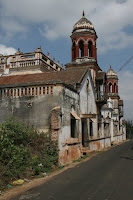The heritage left behind by the Chettiars, who travelled to Southeast Asia as moneylenders and traders in the colonial era, leaving the women behind to look after their grand homes and raise their children, amassed great wealth thanks to their business acumen. The women managed their homes without male support for years on end while the men went about their business in distant lands.
The grand mansions of Chettinad are divided into rectangular spaces, each marked as the domain of men or women. The capacious wedding banquet spaces and the stone loggias where business was conducted are the male spaces and they have high ceilings that are highly decorated. The extended central courtyards are marked out by low arcades whose roofs are held up by beams, each of which has a large iron hook installed. These hooks were where babies’ hammocks were hung. In the quiet of a weekday morning, it is hard to imagine what this courtyard must have looked like, or sounded like, when it was in full use, when a large contingent of women slept here—the family slept in the courtyard, the rooms were used to store valuables—with several babies swinging in their hammocks. Now, only some of those babies still live in these grand homes where they were lulled to sleep on a hammock hung from a beam of the nest Burma teak, over a beautifully tiled floor that was cleaned by hand day after day for years until its dyes gleamed and its surface exuded a warmth that soothes the bare feet, in an arcade whose walls were furnished with eggshells in such a way that their glow evokes moonlight.
This dense accumulation of beauty in palatial spaces had already begun by the middle of the 19th century. The Chettiars were well-established merchant bankers in Southeast Asia and Ceylon. The expansion of British presence in this region brought even greater prosperity to this enterprising community and led to a spurt in building that was to continue until the late 1920s. But then the Great Depression severely affected their fortunes. Later, the Japanese occupation of Burma and finally, the end of colonialism brought an end to the phenomenal run of success that the Chettiars had enjoyed for several generations. Many of them took to other professions. Their descendants work, like many of their contemporaries from Tamil Nadu, in IT and related industries.
 |
| Kanadukathan Chettinadu Palace (The Maharajah's House) |
In Kanadukathan, the ‘capital’ of the Chettinad region because the Raja of Chettinad’s palace is there, we called into Visalam, a hotel operating out of a Chettiar mansion that is built in the Art Deco style. We did not progress beyond the large, welcoming reception area as we were only enquiring about the use of the swimming pool. The oblong dining rooms that run along the sides of most Chettiar homes have here been converted into guest rooms. These are large, airy rooms that manage to convey some of the sense of the space they have been carved out of, despite the amenities of a modern hotel.
Today, only a few homes retain their former contents. Burmese lacquer bowls, rotary phones, compasses and telescopes, spoons and ladles, finely carved chess sets, coffee grinders, door handles and doorknobs, mortars and their pestles, decorative tiles, side panels decorated with a figure of a yali (part horse, part elephant, part lion, part tiger, tiffin boxes, side tables, swings, Tanjore paintings have all been sold as Chettiar families retrieved some capital that helped them make prosperous post-colonial lives. These are now found in local sale rooms, and acquired by those who are converting mansions to hotels, such as the one we stayed in.
Based on an article by Amitabha Bagchi
See also:
• Nemathanpatti
• Kanadukathan























0 comments:
Post a Comment